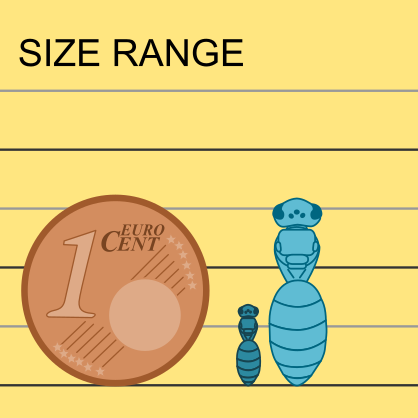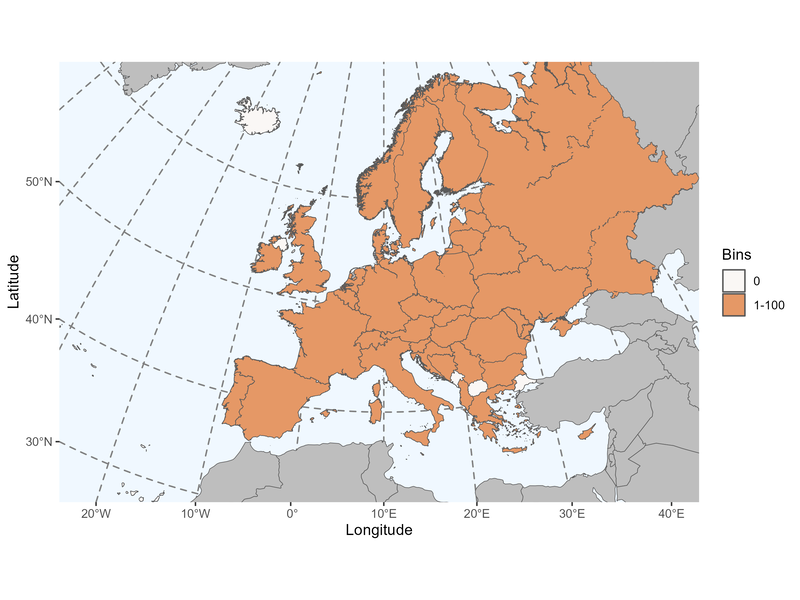Author: Latreille, 1809
|
Type species: Apis conica Linnaeus, 1758 = Apis quadridentata Linnaeus, 1758, by designation of Curtis, 1831.
Subgenera: Allocoelioxys Tkalcu, 1974; Coelioxys s.str. Latreille, 1809; Liothyrapis Cockerell, 1911; Melissoctonia Rocha-Filho, 2016; Paracoelioxys Gribodo, 1884; Rozeniana Rocha-Filho, 2016. Synonyms: Coelioxita Pasteels, 1977; Coelioxula Pasteels, 1982; Liothgraphis Sandhouse, 1943. |
Clade: Anthophila
Family: Megachilidae SubF: Megachilinae Tribe: Megachilini |
|
Distinctive traits
|
Pictures of distinctive traits.
|
Morphologically close genera and how to distinguish them
Paradioxys species have rounded axillae, and 2 spine-like postero-lateral projections of the scutellum.
Aglaoapis, Dioxys & Metadioxys species have rounded axillae, and 2 spine-like postero-lateral projections of the scutellum. The tip of the abdomen is not pointed in females.
Megachile species have 2 rounded axillae. Females do have a scopa. Males have only crenulate, emarginate or two small teeth on tergite 7.
- Coelioxys - Paradioxys
Paradioxys species have rounded axillae, and 2 spine-like postero-lateral projections of the scutellum.
- Coelioxys - Aglaoapis, Dioxys & Metadioxys.
Aglaoapis, Dioxys & Metadioxys species have rounded axillae, and 2 spine-like postero-lateral projections of the scutellum. The tip of the abdomen is not pointed in females.
- Coelioxys - Megachile
Megachile species have 2 rounded axillae. Females do have a scopa. Males have only crenulate, emarginate or two small teeth on tergite 7.
General comments on Coelioxys species identification
Species can be distinguished based on the patterns of hairs patches and apical shape of tergites 6 (females) and 7 (males).
Species can be distinguished based on the patterns of hairs patches and apical shape of tergites 6 (females) and 7 (males).
Sorry, but the species identification tool is not yet available for Coelioxys.
Please check the reference(s) below for traditional keys.
Please check the reference(s) below for traditional keys.
|
List of the 29 Coelioxys species found in Europe (Ghisbain et al. 2023):
Coelioxys (Allocoelioxys) acanthopyga Alfken, 1940 Coelioxys (Allocoelioxys) acanthurus (Illiger, 1806) Coelioxys (Allocoelioxys) argenteus Lepeletier, 1841 Coelioxys (Allocoelioxys) artemis Schwarz, 2001 Coelioxys (Allocoelioxys) brevis Eversmann, 1852 Coelioxys (Allocoelioxys) caudatus Spinola, 1838 Coelioxys (Allocoelioxys) coturnix Pérez, 1884 Coelioxys (Allocoelioxys) echinatus Förster, 1853 Coelioxys (Allocoelioxys) elegantulus Alfken, 1934 Coelioxys (Allocoelioxys) elongatulus Alfken, 1938 Coelioxys (Allocoelioxys) elsei Schwarz, 2001 Coelioxys (Allocoelioxys) emarginatus Förster, 1853 Coelioxys (Allocoelioxys) haemorrhoa Förster, 1853 Coelioxys (Allocoelioxys) mielbergi Morawitz, 1880 Coelioxys (Allocoelioxys) obtusus Pérez, 1884 Coelioxys (Allocoelioxys) polycentris Förster, 1853 |
Coelioxys (Austrocleptria) afer Lepeletier, 1841 Coelioxys (Coelioxys) quadridentatus (L., 1758) Coelioxys (incertae sedis) lanceolatus Nylander, 1852 Coelioxys (incertae sedis) obtusispina Thomson, 1872 Coelioxys (Liothyrapis) decipiens Spinola, 1838 Coelioxys (Melissoctonia) conoideus (Illiger, 1806) Coelioxys (Paracoelioxys) alatus Förster, 1853 Coelioxys (Paracoelioxys) elongatus Lepeletier, 1841 Coelioxys (Paracoelioxys) inermis (Kirby, 1802) Coelioxys (Paracoelioxys) mandibularis Nylander, 1848 Coelioxys (Paracoelioxys) osmiae Alfken, 1928 Coelioxys (Rozeniana) aurolimbatus Förster, 1853 Coelioxys (Rozeniana) rufescens Lepeletier & Serville, 1825 |
References with identification keys for some of the species:
- Amiet, F., Herrmann, M., Müller, A., & Neumeyer, R. (2004). Apidae 4: Anthidium, Chelostoma, Coelioxys, Dioxys, Heriades, Lithurgus, Megachile, Osmia, Stelis. Fauna Helvetica 9. Centre suisse de cartographie de la faune (CSCF), Neuchâtel 273pp.
- Ortiz-Sánchez, F. J., Torres, F., & Ornosa, C. (2009). Claves de identificación para las especies ibéricas del género Coelioxys Latreille, 1809 (Hymenoptera, Apoidea, Megachilidae). Graellsia, 65(2), 155-170.
- Falk S.J. (2015) Field Guide to the Bees of Great Britain and Ireland. Bloomsbury wildlife guides. 432 p.
Online resources:
Atlas hymenoptera (Belgium)
BWARS (UK)
Exotic Bee ID (World)
Discover Life (World)
WestPalBees (West Palearctic)
Atlas hymenoptera (Belgium)
BWARS (UK)
Exotic Bee ID (World)
Discover Life (World)
WestPalBees (West Palearctic)
Page contributors:
You noticed a mistake? You have a suggestion to improve this page?
Don't keep it to yourself, please contact us and become a contributor to IDmyBee!
- Adrien Perrard (Dec. 2023)
- Adrien Perrard (Dec. 2019)
You noticed a mistake? You have a suggestion to improve this page?
Don't keep it to yourself, please contact us and become a contributor to IDmyBee!
References used to write this page:
- Ghisbain, G., Rosa, P., Bogusch, P., Flaminio, S., Le Divelec, R., Dorchin, A., Kasparek, M., Kuhlmann, M., Litman, J., Mignot, M., Müller, A., Praz, C., Radchenko, V.G., Rasmont, P., Risch, S., Roberts, S.P.M., Smit, J., Wood, T.J., Michez, D. & Reverte, S. (2023). The new annotated checklist of the wild bees of Europe (Hymenoptera: Anthophila). Zootaxa, 5327(1), 1-147.
- Michener, C.D. 2007. The Bees of the World, 2nd Edition. The John Hopkins University Press, Baltimore.
- Michez D., Rasmont P., Terzo, M., Vereecken, N. 2019. Abeilles d'Europes. Hymenoptères d'Europes, Volume 1. N.A.P. Editions.
- Nieto, A., Roberts, S. P., Kemp, J., Rasmont, P., Kuhlmann, M., García Criado, M., ... & Michez, D. 2014. European red list of bees. Luxembourg: Publication Office of the European Union, 98.
- Rasmont, P., Devalez, Jelle, Pauly, A., Michez, D. & Radchenko, V.G. 2017. Addition to the checklist of IUCN European wild bees (Hymenoptera: Apoidea). Annales de la Société entomologique de France 53: 17-32.



